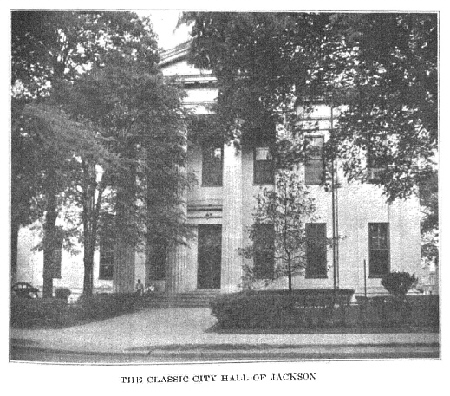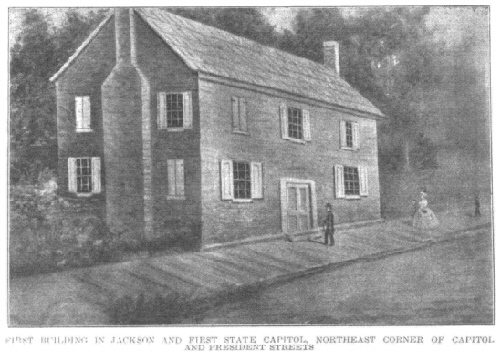.
Hinds
County

HINDS COUNTY
CHAPTER XLVI, pages 734 - 739
Hinds County, located in the west central
part of the State, has been aptly termed the "mother of counties," and
embraces a region which is rich in historic interest. It has a land surface
of 858 square miles.
On February 12, 1821, the Legislature of
the State of Mississippi passed an act declaring that "all that tract of
land ceded to the United States by the Choctaw Nation of Indians on the
18th day of October, 1820, and bounded as follows, that is to say: Beginning
on the Choctaw boundary, east of Pearl River, at a point due south of the
White Oak Spring on the old Indian path; thence in a direct line to a black
oak standing on the Natchez road, about forty poles eastward from Doak’s
Fence, marked A. J., and blazed with two large pines, and a black oak standing
near thereto, and marked as pointers; thence a straight line to the head
of Black Creek, or Bogue Loosa, to a small lake; thence a direct course
so as to strike the Mississippi one mile below the Arkansas River; thence
down the Mississippi to the mouth of the Yazoo River; thence along the
line heretofore known by the name of the Indian Boundary line, to the beginning,
shall be, and is hereby directed and established into a new county, which
shall be called and known by the name of Hinds County."

This fine region of "wide prairies,
fertile valleys, and wooded hills" became rapidly settled and it was soon
thought wise to take from it some of its territory. January 21, 1823, the
legislature created Yazoo County out of Hinds, and by the same act the
county of Copiah. A little later, February 4, 1828, from all that portion
of Hinds County lying east of the Pearl River, the county of Rankin was
erected. And on February 5, 1829, Hinds County surrendered “the fractional
township seven, in ranges two and three—to be attached to Madison County.”
Out of these several counties many other counties have been created, so
that Hinds is indeed the "mother of counties."
It was named in honor of Gen. Thomas Hinds,
who, with General Jackson, were the United States Commissioners appointed
to treat with the Choctaws and obtain the cession noted.

[FIRST BUILDING IN JACKSON
AND FIRST STATE CAPITOL, NORTHEAST CORNER OF CAPITOL
AND PRESIDENT STREETS]
The county, as it exists today, is somewhat
irregular in shape and is bounded on the north by Yazoo and Madison counties,
on the east by Rankin County, on the south by Copiah County, and on the
west by Claiborne and Warren counties. It stands today the most populous
and perhaps the richest and most prosperous county in the State. The capital
of the State was located at Jackson within its borders, November 28, 1821,
and here are centered many of the State’s largest public institutions.
Hinds County is covered with a network
of railroads, which give an outlet in every direction to the products of
its farms and factories. Many prosperous towns and cities dot its surface;
among those which are incorporated may be mentioned Edwards, Clinton and
Learned.
The Pearl River forms its eastern boundary,
the Big Black River part of its western boundary, and numerous tributaries
of these streams yield it ample water power.
Among the earliest settlements in the county
were those at Hamburg, Amsterdam, Antibank and Auburn P. 0., all of which
are now extinct. Hamburg was laid out in 1826, on the Big Black River,
two miles north of the present A. & V. R. R. crossing. The site was
too marshy and the place had a brief career of only two years. Amsterdam
was laid out on the bluffs two miles above Hamburg and became a good sized
village, visited every year during high water by steam and keel boats.
It was even made a port of entry by act of Congress. In 1832 or 1833, one-half
its people were carried off by the cholera, and the A. & V. R. R. missed
it by two miles a few years later; the place never recovered from these
blows. Antibank was first settled in 1836 by T. L. Sumrall. The farmers
around received their supplies at this old landing on the Big Black River.
With the coming of the railroad, it ceased to be a shipping point and is
now part of a cotton farm.
The county seat was at Clinton for a short
time, but on February 4, 1828, the Legislature ordered the election of
five commissioners to locate a site for a court house, and they were directed
to put it in Clinton or within two miles of the center of the county. This
center was found within two miles of Raymond and was marked by a large
stone; next year, by act of the legislature, Raymond was made the county
seat. Here the old records of the county are kept, though courts are also
held at the capital, Jackson, the county being divided into two court districts.
Some of the principal towns in the county
are Jackson, Clinton, Utica, Bolton, Edwards, Terry, Learned, Oakley and
Byram. Jackson had a population of 7,816 in 1900, 21,262 in 1910, and 22,817
in 1920, and has become the most important railroad center in the State.
It is the junction of the Yazoo & Mississippi Valley R. R., the Alabama
& Vicksburg, the Illinois Central and its Yazoo branch running to Yazoo
City, the Gulf & Ship Island and the New Orleans Great Northern.
Hinds County exceeds all the other counties
in the State in the extent of its manufactured products. The census of
1920 valued them at $13,789,000. Jones and Lauderdale each had an output
of about $10,000,000, and were second and third to Hinds County, having
Laurel and Meridian as their important manufacturing centers. The 55 establishments
in Jackson were credited with an output in 1919 of $11,400,000.
Jackson is not only the railroad, financial,
industrial and commercial hub of Mississippi, but its political center.
It is rapidly improving in street conveniences and adornment, and metropolitan
structures are arising continually. The center of its architectural pride
is the beautiful and substantial State House, known as the New Capitol
to distinguish it from the Old Capitol, which is still utilized and historically
preserved. Near and within Jackson are also located the State Insane Hospital,
one mile north of the city, and the Institutions for the Blind, and the
Deaf and Dumb. It is the seat of two well known institutions of learning,
Milisaps College and Eelhaven College. At Clinton, a few miles west of
Jackson, on the line of the Alabama & Vicksburg B. B., are located
Mississippi College and Hiliman College, the latter an institution for
the education of young women and formerly known as the Central Female Institute.
Seven miles north of Jackson is located Tougaloo University, devoted to
the education of the negroes of the State of both sexes. One mile northwest
of Clinton formerly stood the beautiful home of Cowles Mead, who was prominent
in the early history of the State and a brilliant member of the constitutional
convention of 1817 from Jefferson County. It was called "Greenwood," but
was destroyed by the soldiers of Grant. Just beyond the western boundary
of the city was "Mt. Salus," the home of Mississippi’s third governor,
Walter Leake.
Hinds County evinces a strong agricultural
and rural life, as well as urban activities. Of its population (57,000)
more than 6,000 are farmers, and of the latter number nearly 5,000 are
negroes. The value of its farm property was $17,903,000 in 1919, and its
crops realized $7,850,000 during that year. The cereals were valued at
$1,738,000 and vegetables at $776,000. Cotton was a bountiful crop, its
cultivation on more than 70,000 acres bringing to the market more than
17,000 bales. Hinds County also raises an abundance of peaches, 18,000
of its 37,000 trees being of bearing age. Its live stock is valued at $3,607,000,
divided as follows: mules, $906,000; horses, $779,000; dairy cattle, $660,000;
swine, $219,000. The dairy products brought to the farmers an income of
$269,000.
Consequently the prosperity of Hinds County
is based as much on agricultural riches as on industrial, commercial and
social substance. Its growth in population is thus given in twenty-year
periods: 1850, 25,340; 1870, 30,488; 1890, 39,279; 1910, 63,726; 1920,
57,110.
Return to
County History Index
MSGenWeb Home
Source:
Mississippi The Heart of the South - By Dunbar Rowland, LL.D - Director
of the Mississippi State Department of Archives and History. Vol.
II Illustrated. Chicago-Jackson; The S. J. Clarke Publishing
Company, 1925. Public Domain
Copyright Notice: All files
and photographs on this site are copyrighted by their creator and/or contributor,
unless otherwise noted. They may be linked to but may not be reproduced
on another site without specific permission from The MSGenWeb State Coordinator
or the Assistant State Coordinator, and/or their contributor. Although
public information is not in and of itself copyrightable, the format in
which they are presented, the notes and comments, etc., are. It is however,
quite permissible to print or save the files to a personal computer for
personal use ONLY.
  
|






